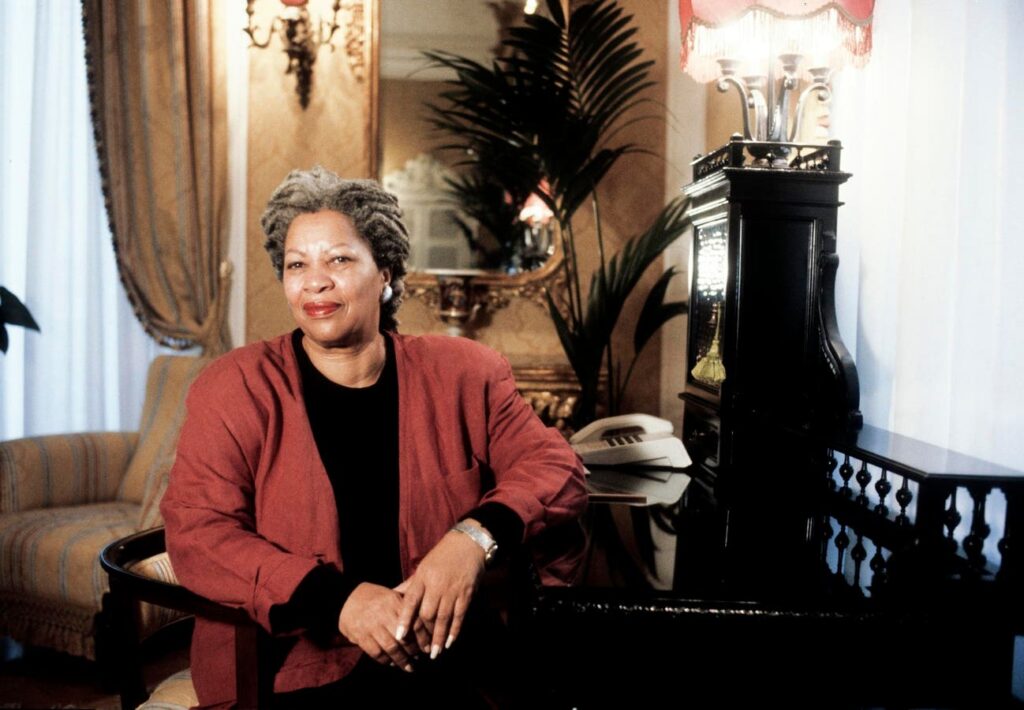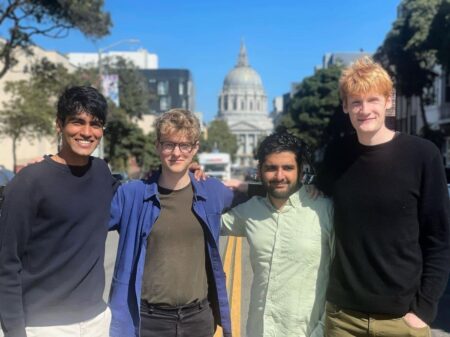Toni Morrison is one of the greatest authors to ever live because she commanded respect and appreciation with everything she wrote and her work was renowned for its rich historical profundity and emotional panoramas. Her lucid accounts of the Black American experience made her an encyclopedia of truth for readers who wanted to see the world with new eyes and truly view the experiences of others with an allegiance to humanity and shared understanding. Morrison’s journey as a writer began while she was raising two sons and working as an editor at Random House. Her debut novel, The Bluest Eye, which she published at 39 years old, was inspired by her own desire to read stories that reflected the complex nature of Black life as captured in her famous quote: “If there’s a book that you want to read, but it hasn’t been written yet, then you must write it.”
As a winner of the Nobel Prize, Pulitzer Prize and Presidential Medal of Freedom, Morrison had ideas that shifted culture, and an approach to her craft that was unlike that of other writers in her generation, one which empowered her to shape stories that have stood out in the literary canon as paradigm shifting. With her words, she transformed the ordinary into the extraordinary, the deflated into the lush, and the mundane into the eccentric, all while transfusing ideas and transcribing the rawness of the human story.
Toni Morrison Books In Order
Morrison’s repertoire is more than a resume; it has become a rich literary reservoir and the legacy of her Midas touch, which has produced several acclaimed Bildungsroman masterpieces like Bluest Eye, magical realism stories like Beloved, and emotional works like Sula, among others. Below are all of Toni Morrison’s best books in order of release.
- The Bluest Eye (1970)
- Sula (1973)
- Song of Solomon (1977)
- Tar Baby (1981)
- Recitatif (1983)
- Beloved (1987)
- Jazz (1992)
- Race-ing Justice, En-gendering Power: Essays on Anita Hill, Clarence Thomas, and the Construction of Social Reality (1992)
- Conversations with Toni Morrison (1994)
- Arguing Immigration: The Controversy and Crisis Over the Future of Immigration in America (1994)
- The Nobel Lecture In Literature (1993 – 1994)
- The Dancing Mind (1996)
- Paradise (1997)
- Birth of a Nation’hood: Gaze, Script, and Spectacle in the O.J. Simpson Case (1997)
- The Big Box (1999)
- The Bluest Eye Teacher Guide (2001)
- The Book of Mean People (2002)
- Love (2003)
- Who’s Got Game? The Ant or the Grasshopper? (2003)
- The lion or the mouse? (2003)
- Toni Morrison’s Song of Solomon: A Casebook (2003)
- Poppy or the snake? (2004)
- Remember: The Journey to School Integration (2004)
- A Mercy (2008)
- What Moves at the Margin: Selected Nonfiction (2008)
- Burn This Book (2009)
- Burn This Book: PEN Writers Speak Out on the Power of the Word (2009)
- Peeny Butter Fudge (2009)
- Everyman’s Library (2010)
- Home (2012)
- Please, Louise (2014)
- God Help the Child (2015)
- Race: Vintage Minis (2017)
- The Origin of Others (2017)
- The Measure of Our Lives: A Gathering of Wisdom (2019)
- The Source of Self-Regard: Selected Essays, Speeches, and Meditations (2019)
- Mouth Full of Blood: Essays, Speeches, Meditations (2019)
- Goodness and the Literary Imagination: Harvard’s 95th Ingersoll Lecture with Essays on Morrison’s Moral and Religious Vision (2019)
Top Toni Morrison Novels
Toni Morrison wrote across multiple genres, pouring her intelligence and knowledge into important issues. Throughout her career, Morrison wrote 11 novels as well as books in other genres including non-fiction, short stories, essays, political commentary and children’s literature, which she co-authored with her son Slade Morrison across a decade. Below are Morrison’s top novels, ranked.
11. Love (2003)
Morrison’s non-linear eighth novel, Love, centers around the story of the affluent Bill Cosey, his family and the women influenced by his life and legacy. Love specifically examines the life of Heed and Christine, two women bound together by a shared past involving the wealthy Cosey family. Their complex relationship, marked by rivalry and reconciliation, unfolds against a backdrop of personal and communal history. Morrison’s rich prose split narrative, and creative use of complex character development captures the story’s nuances in its various and complex forms.
Who should read this book: This book is recommended for readers who enjoy stories that center around character-driven plots and complex human relationships.
Where to read this book: Penguin Random House.
10. Paradise (2003)
The nine-part novel Paradise is about Ruby, a small, all-Black patriarchal town in Oklahoma, that was built by descendants of freed slaves and refugees escaping a hostile world, and which is governed by a stringent sense of duty and morality. Just 17 miles away is another town called Convent, where women revolt against the agenda of Ruby’s male-dominated society. When the men of Ruby accuse the Convent women of corrupting their community, a violent confrontation breaks out and culminates in nine men unleashing their vitriolic violence and rage on four women. The novel handles themes of utopia, community and the clash that can often converge on the cusp of tradition and change.
Who should read this book: This book is ideal for readers who enjoy dystopian-themed novels.
Where to read this book: Barnes and Noble.
9. Recitatif (1983)
Morrison had the innate ability to write about race across various genres in a way that never became watered down. Recitatif, which Morrison originally titled Confirmation: An Anthology of African American Women, is her only short story, and it follows the bond between childhood friends Twyla and Roberta, who lose contact after they grow older and get on with life. Years later, the two friends reconnect but realize that time and experience have changed their perception. The transformative power of time and experience is a central theme in Recitatif, prompting readers to reflect on their own assumptions and biases.
Who should read this book: Readers who enjoy dialogues around race and social issues.
Where to read this book: Penguin Random House.
8. A Mercy (2008)
Set in the late 17th century, A Mercy is a significant and beautifully-written portrayal of the early days of slavery. It tells the story of Florens, a young slave girl abandoned by her mother and given up in exchange for bad debt to Jacob Vaark, an Anglo-Dutch trader. Florens, a literate young girl, was exchanged to replace a bad debt from a plantation owner in Catholic Maryland and to comfort Rebekkah, his lonely wife. On her new master’s farm in rural New York, Florens seeks comfort and acceptance in Lina, an older Native American servant woman, and a handsome African who has never been enslaved. In this novel, Morrison provides readers with insight into the historical dynamics between men and women in those early days.
Who should read this book: This book is perfect for historical fiction enthusiasts and those interested in the origins of American slavery.
Where to read this book: Penguin Random House.
7. Jazz (1992)
In Jazz, Morrison invites readers to 1920s Harlem, crafting a story that is both fluid and improvisational. The novel revolves around Joe Trace, a door-to-door salesman who kills his young lover, Violet, his wife, also known as “Violent,” who tries to attack her husband’s lover’s corpse with a knife at the funeral. Like Langston Hughes’ jazz poetry writing style, Morrison uses a writing technique similar to how jazz music is played and conveys her ideas in a complex, sensuous way while analyzing themes of betrayal, love, injustice and redemption.
Who should read this book: Readers who enjoy jazz music and Harlem Renaissance-themed stories.
Where to read this book: Penguin Random House.
6. Sula (1973)
Morrison’s Sula is a spin on friendship, camaraderie and the beauty of human connection. Sula tells the story of two friends, Sula Peace and Nel Wright who grow up in the Midwest as childhood friends but later take divergent paths define their lives and their community. Set in Morrison’s prominent geographical canvas, Ohio, the novel examines friendship, betrayal and the complex nature of good colliding with evil through the perspective of the women’s contrasting choices and their impact. Sula is a story whose characters force readers to ask questions about the grey areas of friendship and gives insight into the impact of Black womanhood on community trajectories. Morrison follows the progression and ebbs and flows of Sula and Nel’s friendship, from childhood to death.
Who should read this book: This book is ideal for those interested in stories around themes of friendship, morality and community.
Where to read this book: Penguin Random House.
5. Tar Baby (1981)
Set on a Caribbean Island, Tar Baby is a modern-day romance novel focusing on the rocky relationship between Black fashion model Jadine Childs, a fashion model, and Son, a Black drifter. Jadine and Son live different lives and approach their Blackness from different tangents. More importantly, Morrison shows the sharp contrast between Jadine’s assimilation into white culture and the privilege that can come with it, and Son’s contrasting perspective, which has been informed by his life of poverty. Skillfully, Morrison uses different settings to show their affair and examine issues of race, culture, loyalty and betrayal.
Who should read this book: Readers who are curious about the intersection of race, loyalty and class.
Where to read this book: Penguin Random House.
4. The Source of Self-Regard (2019)
Among Morrison’s most notable works is The Source of Self-Regard, a compilation of powerful essays, speeches, meditations, a eulogy and decades of knowledge by Morrison all condensed into what would become the last of her works to be published before she died. The book is a wealth of knowledge and covers topics from race and history to art and culture, female empowerment, human rights, the Black American experience, and an intersection of several other matters. At its core, this compilation offers a pigmented understanding of Morrison’s thoughts and observations over several decades. More impressively, Morrison also gives a unique take on some of her most prominent works and offers some self-reflection on those works. More than anything, this book showcases the breadth of Morrison’s intelligence and elegance, not just as a novelist but as an ever-evolving thinker and social commentator.
Who should read this book: Fans of Morrison who appreciate her thought-provoking essays and speeches on social and cultural issues.
Where to read this book: Penguin Random House.
3. Song of Solomon (1977)
In Song of Solomon, Morrison shows that she is a master of storytelling and, indeed, a master of the novel craft by digging into the generational story of Michigan-based Macon “Milkman” Dead III and his journey to self-discovery. The epic plot spans several decades, giving readers a three-dimensional insight into Milkman’s adventure to find his roots and cultural heritage. The plot’s narrative, rich with symbolism, complex characters and evocative imagery, is a captivating journey for readers. The book was met with national acclaim after its release, and in 1978, it won the National Book Critics Circle Award for Fiction. Although the book was well-received, some controversy came along with that acclaim. Between the ‘90s and early 2000s, several schools across the United States banned the book, citing that it contained degrading and sexually lewd content. However, most of those bans were later lifted.
Who should read this book: This is an ideal book for readers who are curious about complex family and cultural heritage.
Where to read this book: Penguin Random House.
2. The Bluest Eye (1970)
Morrison’s classic debut novel, The Bluest Eye, is a welcoming introduction to readers who haven’t read any of her work before. In this non-polemic novel, Morrison incisively analyzes the destructive influence of racism and its translation and perceptions of beauty standards through the story of 11-year-old Pecola Breedlove, a young Black girl from an abusive home who yearns for acceptance, but more importantly, blue eyes. Set in 1940s Lorain, Ohio — Morrison’s hometown — the novel notes how societal pressures devastate Pecola’s life, leading to a tragic conclusion. Morrison’s unflinching prose delves into themes of identity, community and the longing for what can seem to be unattainable acceptance. Some critics consider Morrison’s The Bluest Eye to be one of her best works because in many ways, the novel set the tone for her career, although its popularity grew years after its release.
Who should read this book: Readers who are interested in racial and social issues will appreciate this book.
Where to read this book: Penguin Random House.
1. Beloved (1987)
Morrison’s magnum opus, Beloved, is a poignant story about the trauma of slavery and its lasting scars. The novel follows the story of Sethe, a freed slave who is still traumatized by the ghost of her daughter, and the farm Sweet Home in Kentucky, where she endured horrifying experiences even years after she became free. Set in post-Civil War America, the novel takes a grim and brutally honest approach to the trauma of slavery survivors. It presents their experiences in a way that is deeply personal to each character, yet universally significant to all who read it. Morrison’s Pulitzer-winning Beloved is the true story of Margaret Garner, who escaped from a Kentucky plantation in 1856 with her family but was later re-captured. Instead of allowing her daughter to return to slavery, Margaret kills her daughter, which leads her enslaver to believe that she is mentally deranged, and this leads her owner to refuse to keep her.
Who should read this book: Beloved is an essential read for those who enjoy historically rich and emotionally charged stories.
Where to read this book: Penguin Random House.
Bottom Line
Toni Morrison’s work, which includes novels, non-fiction and children’s books, has significantly contributed to readers’ understanding and appreciation of Black culture. Her most acclaimed novels, including Beloved, The Bluest Eye and Song of Solomon, have combined the richness of the Black identity and its existence in society, securing her as an icon of literary repute.
Read the full article here














